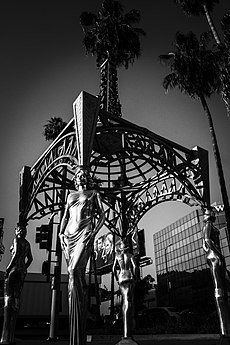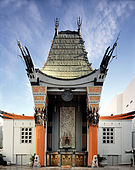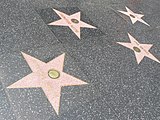Hollywood
This article is currently protected from editing. See the protection policy and protection log for more details. Please discuss any changes on the talk page; you may submit an edit request to ask an administrator to make an edit if it is uncontroversial or supported by consensus. You may also request that this page be unprotected. |
Hollywood | |
|---|---|
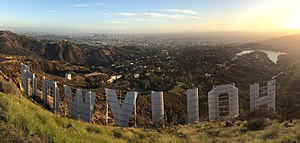 Hollywood as seen from the Hollywood Sign | |
 Map of the Hollywood neighborhood of Los Angeles as delineated by the Los Angeles Times | |
| Error de Lua en Módulo:Location_map en la línea 410: Malformed coordinates value. | |
| Coordinates: 34°06′06″N 118°19′36″O / 34.10167, -118.32667{{#coordinates:34|06|06|N|118|19|36|W|
|primary |name= }} | |
| Country | |
| State | |
| County | |
| City | |
| Incorporated | 1903 |
| Merged with Los Angeles | 1910 |
| Elevation | 354 ft (108 m) |
| Area code | 323 |
Hollywood is a neighborhood in the central region of Los Angeles, California. Its name has come to be a shorthand reference for the U.S. film industry and the people associated with it. Many of its studios such as Paramount Pictures, Warner Bros., and Universal Pictures were founded there and Paramount still has its studios there.
Hollywood was incorporated as a municipality in 1903.[2][3] It was consolidated with the city of Los Angeles in 1910, and soon thereafter a prominent film industry emerged, eventually becoming the most recognizable in the world.[4][5]
History
Early history and development
H.J. Whitley, a real estate developer, arranged to buy the 480-acre (190 ha) E.C. Hurd ranch. They agreed on a price and shook hands on the deal. Whitley shared his plans for the new town with General Harrison Gray Otis, publisher of the Los Angeles Times, and Ivar Weid, a prominent businessman in the area.[citation needed]

Daeida Wilcox, who donated land to help in the development of Hollywood, learned of the name Hollywood from an acquaintance who owned an estate by that name in Illinois.[6] She recommended the same name to her husband, Harvey H. Wilcox, who had purchased 120 acres on February 1, 1887. It wasn't until August 1887 Wilcox decided to use that name and filed with the Los Angeles County Recorder's office on a deed and parcel map of the property.
By 1900, the region had a post office, newspaper, hotel, and two markets. Los Angeles, with a population of 102,479 lay 10 miles (16 km) east through the vineyards, barley fields, and citrus groves. A single-track streetcar line ran down the middle of Prospect Avenue from it, but service was infrequent and the trip took two hours. The old citrus fruit-packing house was converted into a livery stable, improving transportation for the inhabitants of Hollywood.
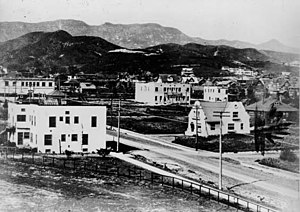
The Hollywood Hotel was opened in 1902 by Whitley, who was a president of the Los Pacific Boulevard and Development Company. Having finally acquired the Hurd ranch and subdivided it, Whitley built the hotel to attract land buyers. Flanking the west side of Highland Avenue, the structure fronted on Prospect Avenue, which, still a dusty, unpaved road, was regularly graded and graveled. The hotel was to become internationally known and was the center of the civic and social life and home of the stars for many years.[7]
Whitley's company developed and sold one of the early residential areas, the Ocean View Tract.[8] Whitley did much to promote the area. He paid thousands of dollars for electric lighting, including bringing electricity and building a bank, as well as a road into the Cahuenga Pass. The lighting ran for several blocks down Prospect Avenue. Whitley's land was centered on Highland Avenue.[9][10] His 1918 development, Whitley Heights, was named for him.
Incorporation and merger
Hollywood was incorporated as a municipality on November 14, 1903, by a vote of 88 for and 77 against. On January 30, 1904, the voters in Hollywood decided, by a vote of 113 to 96, to banish the sale of liquor within the city, except for medicinal purposes. Neither hotels nor restaurants were allowed to serve wine or liquor before or after meals.[11]
In 1910, the city voted for a merger with Los Angeles in order to secure an adequate water supply and to gain access to the L.A. sewer system. With annexation, the name of Prospect Avenue was changed to Hollywood Boulevard and all the street numbers were also changed.[12]
Motion picture industry
By 1912, major motion-picture companies had set up production near or in Los Angeles.[13] In the early 1900s, most motion picture patents were held by Thomas Edison's Motion Picture Patents Company in New Jersey, and filmmakers were often sued to stop their productions. To escape this, filmmakers began moving out west to Los Angeles, where attempts to enforce Edison's patents were easier to evade.[14] Also, the weather was ideal and there was quick access to various settings. Los Angeles became the capital of the film industry in the United States.[15] The mountains, plains and low land prices made Hollywood a good place to establish film studios.[16]
Director D. W. Griffith was the first to make a motion picture in Hollywood. His 17-minute short film In Old California (1910) was filmed for the Biograph Company.[17][18][19] Although Hollywood banned movie theaters—of which it had none—before annexation that year, Los Angeles had no such restriction.[20]
The first studio in Hollywood, the Nestor Company, was established by the New Jersey–based Centaur Company in a roadhouse at 6121 Sunset Boulevard (the corner of Gower), in October 1911.[21] Four major film companies – Paramount, Warner Bros., RKO, and Columbia – had studios in Hollywood, as did several minor companies and rental studios. In the 1920s, Hollywood was the fifth-largest industry in the nation.[15] By the 1930s, Hollywood studios became fully vertically integrated, as production, distribution and exhibition was controlled by these companies, enabling Hollywood to produce 600 films per year.[16]
Hollywood became known as Tinseltown[22] and the "dream factory"[16] because of the glittering image of the movie industry. Hollywood has since[when?] become a major center for film study in the United States.
Development

A large sign reading HOLLYWOODLAND was erected in the Hollywood Hills in 1923 to advertise a housing development. In 1949, the Hollywood Chamber of Commerce entered a contract with the City of Los Angeles to repair and rebuild the sign. The agreement stipulated that LAND be removed to spell HOLLYWOOD so the sign would now refer to the district, rather than the housing development.[23]
During the early 1950s, the Hollywood Freeway was constructed through the northeast corner of Hollywood.
The Capitol Records Building on Vine Street, just north of Hollywood Boulevard, was built in 1956, and the Hollywood Walk of Fame was created in 1958 as a tribute to artists and other significant contributors to the entertainment industry. The official opening was on February 8, 1960.[24][25][26]
The Hollywood Boulevard Commercial and Entertainment District was listed in the National Register of Historic Places in 1985.
In June 1999, the Hollywood extension of the Los Angeles County Metro Rail Red Line subway opened from Downtown Los Angeles to the San Fernando Valley, with stops along Hollywood Boulevard at Western Avenue (Hollywood/Western Metro station), Vine Street (Hollywood/Vine Metro station), and Highland Avenue (Hollywood/Highland Metro station).
The Dolby Theatre, which opened in 2001 as the Kodak Theatre at the Hollywood & Highland Center mall, is the home of the Oscars. The mall is located where the historic Hollywood Hotel once stood.
Revitalization
After the neighborhood underwent years of serious decline in the 1980s, many landmarks were threatened with demolition.[27] Columbia Square, at the northwest corner of Sunset Boulevard and Gower Street, is part of the ongoing rebirth of Hollywood. The Art Deco-style studio complex completed in 1938, which was once the Hollywood headquarters for CBS, became home to a new generation of broadcasters when cable television networks MTV, Comedy Central, BET and Spike TV consolidated their offices here in 2014 as part of a $420-million office, residential and retail complex.[28] Since 2000, Hollywood has been increasingly gentrified due to revitalization by private enterprise and public planners.[29][30][31] Over 1,200 hotel rooms have been added in Hollywood area between 2001 and 2016. Four thousand new apartments and over thirty low to mid-rise development projects were approved in 2019.[32]
Secession movement
In 2002, some Hollywood voters began a campaign for the area to secede from Los Angeles and become a separate municipality. In June of that year, the Los Angeles County Board of Supervisors placed secession referendums for both Hollywood and the San Fernando Valley on the ballot. To pass, they required the approval of a majority of voters in the proposed new municipality as well as a majority of voters in all of Los Angeles. In the November election, both measures failed by wide margins in the citywide vote.[33]
Geography
According to the Mapping L.A. project of the Los Angeles Times, Hollywood is flanked by Hollywood Hills to the north, Los Feliz to the northeast, East Hollywood or Virgil Village to the east, Larchmont and Hancock Park to the south, Fairfax to the southwest, West Hollywood to the west and Hollywood Hills West to the northwest.[34]
Street limits of the Hollywood neighborhood are: north, Hollywood Boulevard from La Brea Avenue to the east boundary of Wattles Garden Park and Franklin Avenue between Bonita and Western avenues; east, Western Avenue; south, Melrose Avenue, and west, La Brea Avenue or the West Hollywood city line.[35][36]
In 1918, H. J. Whitley commissioned architect A. S. Barnes to design Whitley Heights as a Mediterranean-style village on the hills above Hollywood Boulevard, and it became the first celebrity community.[37][38][39]
Other areas within Hollywood are Franklin Village, Little Armenia, Spaulding Square, Thai Town,[35] and Yucca Corridor.[40][41]
Other Hollywoods
In 1994, Hollywood, Alabama, and 10 other towns named Hollywood successfully fought an attempt by the Hollywood Chamber of Commerce to trademark the name and force same-named communities to pay royalties to it.[42]
Climate
| Climate data for Hollywood, Los Angeles, California | |||||||||||||
|---|---|---|---|---|---|---|---|---|---|---|---|---|---|
| Month | Jan | Feb | Mar | Apr | May | Jun | Jul | Aug | Sep | Oct | Nov | Dec | Year |
| Source: The Weather Channel[43] | |||||||||||||
Demographics
The 2000 U.S. census counted 77,818 residents in the 3.51-square-mile (9.1 km2) Hollywood neighborhood—an average of 22,193 people per square mile (8,569 per km2), the seventh-densest neighborhood in all of Los Angeles County. In 2008 the city estimated that the population had increased to 85,489. The median age for residents was 31, about the city's average.[35]
Hollywood was said to be "highly diverse" when compared to the city at large. The ethnic breakdown in 2000 was 42.2% Latino or Hispanic, 41% Non-Hispanic White, 7.1% Asian, 5.2% black, and 4.5% other.[35] Mexico (21.3%) and Guatemala (13%) were the most common places of birth for the 53.8% of the residents who were born abroad, a figure that was considered high for the city as a whole.[35]
The median household income in 2008 dollars was $33,694, considered low for Los Angeles. The average household size of 2.1 people was also lower than the city norm. Renters occupied 92.4% of the housing units, and home- or apartment owners the rest.[35]
The percentages of never-married men (55.1%), never-married women (39.8%) and widows (9.6%) were among the county's highest. There were 2,640 families headed by single parents, about average for Los Angeles.[35]
In 2000, there were 2,828 military veterans, or 4.5%, a low rate for the city as a whole.[35] These were the ten neighborhoods or cities in Los Angeles County with the highest population densities, according to the 2000 census, with the population per square mile:[44]
- Koreatown, Los Angeles, 42,611
- Westlake, Los Angeles, 38,214
- East Hollywood, Los Angeles, 31,095
- Pico-Union, Los Angeles, 25,352
- Maywood, California, 23,638
- Harvard Heights, Los Angeles, 23,473
- Hollywood, Los Angeles, 22,193
- Walnut Park, California, 22,028
- Palms, Los Angeles, 21,870
- Adams-Normandie, Los Angeles, 21,848
Radio and television
KNX was the last radio station to broadcast from Hollywood before it left CBS Columbia Square for a studio in the Miracle Mile in 2005.[45]
On January 22, 1947, the first commercial television station west of the Mississippi River, KTLA, began operating in Hollywood. In December of that year, The Public Prosecutor became the first network television series to be filmed in Hollywood. Television stations KTLA and KCET, both on Sunset Boulevard, are the last broadcasters (television or radio) with Hollywood addresses, but KCET has since sold its studios on Sunset and plans to move to another location. KNBC moved in 1962 from the former NBC Radio City Studios at the northeast corner of Sunset Boulevard and Vine Street to NBC Studios in Burbank. KTTV moved in 1996 from its former home at Metromedia Square on Sunset Boulevard to West Los Angeles, and KCOP left its home on La Brea Avenue to join KTTV on the Fox lot. KCBS-TV and KCAL-TV moved from their longtime home at CBS Columbia Square on Sunset Boulevard to a new facility at CBS Studio Center in Studio City.
Government
As a neighborhood within the Los Angeles city limits, Hollywood does not have its own municipal government. A person was appointed by the Hollywood Chamber of Commerce to serve as an honorary "Mayor of Hollywood" for ceremonial purposes. Johnny Grant held this position from 1980 until his death on January 9, 2008.[46]
Emergency service
The Los Angeles Police Department is responsible for police services. The Hollywood police station is at 1358 N. Wilcox Ave.
Los Angeles Fire Department operates four fire stations – Station 27, 41, 52, and 82 – in the area.
The Los Angeles County Department of Health Services operates the Hollywood-Wilshire Health Center in Hollywood.[47]
Post office
The United States Postal Service operates the Hollywood Post Office,[48] the Hollywood Pavilion Post Office,[49] and the Sunset Post Office.[50]
Neighborhood councils
Hollywood is included within the Hollywood United Neighborhood Council (HUNC),[51] Hollywood Hills West Neighborhood Council,[52][53] and the Hollywood Studio District Neighborhood Council.[54][55] Neighborhood Councils cast advisory votes on such issues as zoning, planning, and other community issues. The council members are voted in by stakeholders, generally defined as anyone living, working, owning property, or belonging to an organization within the boundaries of the council.[56]
Education

Hollywood residents aged 25 and older holding a four-year degree amounted to 28% of the population in 2000, about the same as in the county at large.[35]
Public libraries
The Will and Ariel Durant Branch, John C. Fremont Branch, and the Frances Howard Goldwyn – Hollywood Regional Branch of the Los Angeles Public Library are in Hollywood.
Schools
Public schools are operated by the Los Angeles Unified School District (LAUSD).
Schools in Hollywood include:
- Temple Israel of Hollywood Day School, private, 7300 Hollywood Boulevard
- Gardner Street Elementary School, LAUSD, 7450 Hawthorne Avenue
- Selma Avenue Elementary School, LAUSD, 6611 Selma Avenue
- Grant Elementary School, 1530 North Wilton Place
- Young Hollywood, private elementary, 1547 North McCadden Place
- Hollywood High School, LAUSD, 1521 North Highland Avenue[57]
- Hollywood Community Adult School, LAUSD, 1521 North Highland Avenue
- Blessed Sacrament School, private elementary, 6641 Sunset Boulevard
- Helen Bernstein High School, LAUSD, 1309 North Wilton Place
- Richard A. Alonzo Community Day School, LAUSD, 5755 Fountain Avenue
- Beverly Hills RC School, private elementary, 6550 Fountain Avenue
- Hollywood Schoolhouse, private elementary, 1233 North McCadden Place
- Joseph LeConte Middle School, LAUSD, 1316 North Bronson Avenue
- Hollywood Primary Center, LAUSD elementary, 1115 Tamarind Avenue
- Santa Monica Boulevard Community Charter School, 1022 North Van Ness Avenue
- Vine Street Elementary School, LAUSD, 955 North Vine Street
- Hubert Howe Bancroft Middle School, LAUSD, 929 North Las Palmas Avenue
- Larchmont Charter School, elementary, 815 North El Centro Avenue
- Cheder Menachem, private elementary, 1606 South La Cienega Boulevard
Colleges
- Los Angeles Film School, 6363 Sunset Boulevard
- Emerson College, 5960 Sunset Boulevard
- Columbia College Hollywood, 6255 Sunset Boulevard
Notable places
- CBS Columbia Square
- Charlie Chaplin Studios
- Cinerama Dome
- Crossroads of the World
- Dolby Theatre
- Earl Carroll Theatre (currently Nickelodeon on Sunset)
- El Capitan Theatre
- Frederick's of Hollywood
- Gower Gulch
- Grauman's Chinese Theatre
- Grauman's Egyptian Theatre
- Hollywood & Western Building
- Hollywood and Highland Center
- Hollywood and Vine
- Hollywood Forever Cemetery
- Hollywood Heritage Museum
- Hollywood Palladium
- Hollywood Masonic Temple
- Hollywood Museum
- Hollywood Walk of Fame
- Hollywood Wax Museum
- Knickerbocker Hotel
- Madame Tussauds Hollywood
- Musso & Frank Grill
- Pantages Theatre
- Roosevelt Hotel
- Sunset Gower Studios
Special events
- The Academy Awards are held in late February/early March (since 2004) of each year, honoring the preceding year in film. Prior to 2004, they were held in late March/early April. Since 2002, the Oscars have been held at their new home at the Dolby (formerly Kodak) Theater at Hollywood Boulevard and Highland Avenue.
- The annual Hollywood Christmas Parade: The 2006 parade on Nov 26 was the 75th edition of the Christmas Parade. The parade goes down Hollywood Boulevard and is broadcast in the Los Angeles area on KTLA, and around the United States on Tribune-owned stations and the WGN superstation.[58]
- The Hollywood Half Marathon takes place in April (since 2012) of each year, to raise funds and awareness for local youth homeless shelters. The event includes a Half Marathon, 10K, 5K, and Kids Fun Run along Hollywood Blvd.
Gallery
La página Plantilla:Gallery/styles.css debe tener el modelo de contenido "CSS expurgado" para TemplateStyles (el modelo de contenido que tiene actualmente es "texto wiki").
See also
- Community newspapers in Hollywood, California
- History of film
- History of the Jews in Los Angeles § Film
- Category:Documentary films about Hollywood
- Category:Films about Hollywood
- List of films set in Los Angeles
- List of Hollywood-inspired nicknames
- List of Hollywood novels
- List of Los Angeles Historic-Cultural Monuments in Hollywood
- List of television shows set in Los Angeles
- North Hollywood, Los Angeles
- Outline of film
- Studio zone
Error de Lua: bad argument #2 to 'title.new' (unrecognized namespace name 'Portal').
References
- ↑ «Hollywood». Geographic Names Information System. United States Geological Survey. Consultado el 7 de January de 2018.
- ↑ «Los Angeles Herald, Volume XXXI, Number 45». By the California Digital Newspaper Collection (November 15, 1903). Consultado el 22 de February de 2014.
- ↑ «Hollywood Was Once an Alcohol-Free Community». By Rachel Nuwer of smithsonianmag.com. Consultado el 22 de February de 2014.
- ↑ Annual Report of the Controller of the City of Los Angeles, California. ByOffice of Controller Los Angeles, CA (1914). 1914. Consultado el 22 de February de 2014.
- ↑ Report of the Auditor of the City of Los Angeles California of the Financial Affairs of the Corporation in Its Capacity as a City for the Fiscal Year. By Auditor's Office of Los Angeles, CA (1913). 1913. Consultado el 22 de February de 2014.
- ↑ «California Holly: How Hollywood Didn't Get its Name | nhm». nhm.org (en English). Consultado el 14 de February de 2021.
- ↑ Father of Hollywood Dies Hollywood Daily Citizen (1931)
- ↑ Los Angeles from the mountains to the sea: with selected biography ..., Volume 3 By John Steven McGroarty 1921 pg. 815
- ↑ Cahuenga Valley Sentinel (May 7, 1904).
- ↑ Hollywood Citizen (Spring Addition March 4, 1914).
- ↑ [1] "Hollywood Becomes a Prohibition Town," Los Angeles Times, December 29, 1903, page A-3
- ↑ Hollywood California | Hollywood History and Information Archived 2011-02-15 at the Wayback Machine. Abouthollywood.com (November 16, 2010). Retrieved on December 11, 2011.
- ↑ Jacobs, Lewis. The Rise of the American Film Harcourt Brace, New York, 1930; p. 85
- ↑ «History of Hollywood, California». Consultado el 27 de May de 2014.
- ↑ 15,0 15,1 Mintz, S., and S. McNeil. "Hollywood as History." Digital History. N.p., 2013. Web. May 20, 2014.
- ↑ 16,0 16,1 16,2 Hayward, Susan. "Hollywood" in Cinema Studies: The Key Concepts (Third Edition). Routledge, 2006. p. 205
- ↑ Philip French (28 de February de 2010). «How 100 years of Hollywood have charted the history of America». The Guardian. UK. Consultado el 24 de May de 2010.
- ↑ RASMUSSEN, CECILIA (1 de August de 1999). «L.A. Then and Now: Film Pioneer Griffith Rode History to Fame». Los Angeles Times. p. 3.
- ↑ Dyson, Jonathan (4 de March de 2000). «How the West was won Time lapse». The Independent (London (UK)). p. 54.
- ↑ Friedrich, Otto (1986). City of Nets: A Portrait of Hollywood in the 1940s. Berkeley and Los Angeles: University of California Press. p. 6. ISBN 0-520-20949-4.
- ↑ Robertson (2001), p. 21. It later became the Hollywood Film Laboratory, now called the Hollywood Digital Laboratory.
- ↑ Error de Lua en Módulo:Citation/CS1/Configuration en la línea 2083: attempt to index field '?' (a nil value).
- ↑ Slide, Anthony (25 de February de 2014). The New Historical Dictionary of the American Film Industry (en English). Routledge. p. 94. ISBN 9781135925543.
- ↑ History of WOF Archived 2010-06-12 at the Wayback Machine hollywoodchamber.net; Hollywood Chamber of Commerce. Retrieved May 31, 2010.
- ↑ "Kramer First Name Put in Walk of Fame"(abstract). Los Angeles Times, March 29, 1960, p. 15. Full article: LA Times Archives Retrieved June 12, 2010.
- ↑ Martin, Hugo (8 de February de 2010). «Golden milestone for the Hollywood Walk of Fame». Los Angeles Times. Consultado el 6 de March de 2016.
- ↑ Leavitt, B. Russell (6 de June de 1982). «In California: A Fading Hollywood». Time Magazine. Consultado el 14 de January de 2014. (subscription may be required for this article)
- ↑ Vincent, Roger (19 de November de 2014). «Viacom signs 12-year lease at Columbia Square in Hollywood». Los Angeles Times.
- ↑ Kotkin, Joel (Summer 2012). «Let L.A. be L.A.» 22 (3). New York City: City Journal.
- ↑ Lin II, Rong-Gong; Zahniser, David; Xia, Rosanna (30 de April de 2015). «Judge halts Millennium Hollywood skyscraper project». Los Angeles Times.
- ↑ Vincent, Roger (30 de January de 2014). «Vine Street resurgence continues with $285-million mixed-use project». Los Angeles Times.
- ↑ https://la.curbed.com/maps/hollywood-development-hotels-apartments-construction
- ↑ Grand, Noah (5 de November de 2002). «Valley, Hollywood secession measures fail». Daily Bruin. Consultado el 29 de December de 2013.
- ↑ «"Central L.A.," Mapping L.A., Los Angeles Times». Projects.latimes.com. Consultado el 14 de January de 2014.
- ↑ 35,0 35,1 35,2 35,3 35,4 35,5 35,6 35,7 35,8 «"Hollywood," Mapping L.A., Los Angeles Times». Projects.latimes.com. Consultado el 14 de January de 2014.
- ↑ The Thomas Guide, Los Angeles County 2006, page 593
- ↑ «About». Whitley Heights. Archivado desde el original el 18 de August de 2013. Consultado el 14 de January de 2014. Parámetro desconocido
|url-status=ignorado (ayuda) - ↑ «Whitley Heights | Office of Historic Resources, City of Los Angeles». Preservation.lacity.org. Consultado el 14 de January de 2014.
- ↑ «About». Whitley Heights. Archivado desde el original el 18 de August de 2013. Consultado el 14 de January de 2014. Parámetro desconocido
|url-status=ignorado (ayuda) - ↑ «Archived copy». Archivado desde el original el 22 de December de 2015. Consultado el 21 de December de 2015. Parámetro desconocido
|url-status=ignorado (ayuda) Yucca Corridor Coalition website - ↑ Monte Morin, "A Look Ahead: Activists Are Stepping Up Efforts on Their New Cause and Meeting Strong Business Opposition," Los Angeles Times, August 23, 1999, page 1
- ↑ [2]
- ↑ «Monthly Averages for Los Angeles (90028)». www.weather.com. Consultado el 31 de October de 2017.
- ↑ «Population Density». Los Angeles Times. Mapping L.A. Consultado el 12 de June de 2016.
- ↑ Bob Pool, "Hollywood, Radio Finally Part Waves," Los Angeles Times, August 11, 2005
- ↑ «Johnny Grant, honorary Hollywood mayor, dies». CNN. 10 de January de 2008. Consultado el 12 de January de 2008.
- ↑ "Hollywood-Wilshire Health Center." Los Angeles County Department of Health Services. Retrieved March 18, 2010.
- ↑ "Post Office Location – HOLLYWOOD Archived 2010-03-30 at the Wayback Machine." United States Postal Service. Retrieved March 18, 2010.
- ↑ "Post Office Location – HOLLYWOOD PAVILION Archived 2010-02-27 at the Wayback Machine." United States Postal Service. Retrieved March 18, 2010.
- ↑ "Post Office Location – SUNSET Archived 2010-03-11 at the Wayback Machine." United States Postal Service. Retrieved March 18, 2010.
- ↑ «Hollywood United Neighborhood Council». Hollywoodunitednc.org. Consultado el 14 de January de 2014.
- ↑ «WELCOME | Hollywood Hills West». Hhwnc.org. 10 de December de 2013. Consultado el 14 de January de 2014.
- ↑ «Hollywood Hills West Neighborhood Council Bylaws - Area Boundaries». Hhwnc.org. 15 de February de 2012. Archivado desde el original el 21 de January de 2014. Consultado el 14 de January de 2014. Parámetro desconocido
|url-status=ignorado (ayuda) - ↑ Hollywood Studio District Neighborhood Council (1 de January de 2014). «Hollywood Studio District Neighborhood Council». Hsdnc.org. Consultado el 14 de January de 2014.
- ↑ «Los Angeles Department of Neighborhood Enpowerment». Done.lacity.org. 20 de January de 2012. Archivado desde el original el 14 de November de 2013. Consultado el 14 de January de 2014. Parámetro desconocido
|url-status=ignorado (ayuda) - ↑ «HSDNC.org: FAQs». Archivado desde el original el 8 de December de 2008. Parámetro desconocido
|url-status=ignorado (ayuda) - ↑ «Hollywood High School».
- ↑ [3] Archived julio 7, 2009, at the Wayback Machine
Error de Lua en Módulo:Authority_control en la línea 158: attempt to index field 'wikibase' (a nil value).
- Páginas con errores en secuencias de órdenes
- Páginas con errores de TemplateStyles
- Webarchive template wayback links
- Wikipedia:Páginas con referencias con parámetros desconocidos
- Articles with short description
- Use mdy dates from November 2020
- Articles with invalid date parameter in template
- Articles with hatnote templates targeting a nonexistent page
- Wikipedia fully protected pages
- Pages using infobox settlement with bad settlement type
- All articles with unsourced statements
- Articles with unsourced statements from March 2020
- All articles with vague or ambiguous time
- Vague or ambiguous time from April 2019
- Commons category link is defined as the pagename
- Hollywood
- California culture
- Film production districts
- Former municipalities in California
- Neighborhoods in Los Angeles
- Populated places established in 1853
- Central Los Angeles
- Northwest Los Angeles
- 1853 establishments in California







